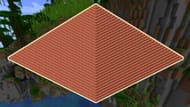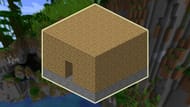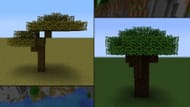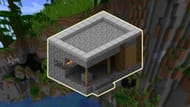Minecraft's structures are some of the most useful features found within the game. Villages give players access to some of the best items out there through Minecraft villager trading, while other structures, such as dungeons and ocean monuments, eventually become farms for useful items and resources.
However, there are some structures lost both to the game and the community, having been removed from world generation at some point. Each of these removed structures from the game's history can be found below.
Minecraft's removed structures
1) Brick pyramids

Brick pyramids were experimental structures consisting entirely of bricks. They generated 127 blocks wide, 127 blocks deep, and 64 blocks tall on average, though terrain would change the layers. Only appearing in infdev, they were the only way to get bricks at the time they were removed.
These structures have no interiors, making them different from other similar structures, such as the desert temples that make Minecraft's best desert seeds amazing, or the jungle temples that do the same for jungles.
2) Starting house

Featured in Indev, the starting house was a basic wooden and stone box with two torches in it. One of the oldest structures in Minecraft, they were originally made of mossy cobblestone, which was otherwise unobtainable. They also originally had chests with every item in the game, as a sort of pseudo-creative mode menu to help builders.
The legacy of the starting house exists for the current game in the starting chest, which contains useful starting items that make the first day much quicker and easier.
3) Obsidian walls

Another interesting structure that only existed for debugging was the obsidian walls. These walls started at 0, 0 and extended out infinitely in each cardinal direction. Before Minecraft's useful f3 menu was added to read coordinates, this was how the location was tracked.
4) Monoliths

Monoliths were a bug of terrain generation that persisted from Infdev to Alpha. Within these areas, terrain generation is flipped, with land generated in the sky and the ground being hollow.
This makes them useful for getting materials due to the exposed ores. This also tended to result in strange underground seas, as the game would default to filling open-air spaces underground and not in caves with water.
5) Placeholder trees

Placeholder trees are an interesting phenomenon found in some of Minecraft's most beautiful biomes. They are trees that cannot be grown by saplings; they are only encountered. Examples include acacia trees made of jungle logs and oak leaves or dark oak trees made of spruce wood and oak leaves.
For as nice as they can be to look at, it's always good to see them removed from the game, as they tend to be replaced with new wood types to use while building.
6) Old villages

The original version of what might inarguably be the best structures in Minecraft were found in plains, savanna, taiga, ice plains, and desert biomes. They persisted until 1.14, which overhauled villagers, villages, and all related systems, including villager trading.
They also featured some other now-defunct structures. Their road used to be a specific structure known as gravel roads, but they were removed when pathway blocks were introduced. Additionally, there used to be specific savanna and desert village variants.
7) Glass pillars

Glass pillars were a temporary measure added to the game. They were towers of glass used to mark the location of stronghold portal rooms needed to reach Minecraft's ender dragon boss fight, as eyes of ender hadn't yet been coded to work. They were removed once eye of ender functionality was added, a true shame as finding the portal room can sometimes be a struggle.
8) Nether reactors

Nether reactors are an interesting structure, as they were not natural but rather player-constructed. This made them more similar to the game's golems than a regular structure. They were three-by-three areas made up of cobblestone, gold blocks, and a Nether reactor core. When activated, a large spire kf netherrack spawns, along with many normally unobtainable items.
This structure was removed when the Nether was added to Bedrock, which was unfortunate, as it was definitely a unique feature.
Obsessed with Crosswords, Wordle, and other word games? Take our quick survey and let us get to know you better!
